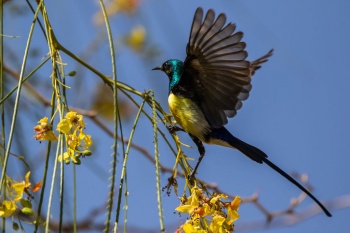- Hedydipna metallica
Anthreptes metallicus
Identification
Male 17 cm(6¾ in), female 9 cm (3½ in)
- Decurved bill
Male breeding: 5 cm tail
- Fork shape tail
- Metallic dark green head with dark green
- Blue-violet back
- Yellow underparts
Non-breeding
- Loses long tail
- Plumage similar to female, but has some black patches (lacking in female)
Female
- Yellow-brown upper parts
- Less vibrant yellow belly
Distribution
Breeds from Egypt (primarily the Nile Valley) to Sudan, northeastern South Sudan, Eritrea, northern Ethiopia, Djibouti, northwestern Somalia, southwestern Saudi Arabia, Yemen, and southwestern Oman; nonbreeding visitor to northern Egypt (Cairo) and northern eastern Somalia.
Taxonomy
This is a monotypic species[1].
This is one of the four Sunbirds that have recently been moved to the genus Hedydipna from the genus Anthreptes.
Habitat
A familiar bird in the gardens of Jeddah and Taif, Khmis mushayt and Abha western Saudi Arabia. In dry acacia scrubs in wadies and plane of eastern cost of the red sea and at juniper woodlands at the high altitude (2500m) mountens of Asir and Yemen.
Behaviour
Diet
Feeds on nectar and arthropods.
Vocalisation
Starting from December both the male and female start to announce there presence with calls far from Twitter, but rather similar to little kittens calls. They keep on sending these calls which tend to get higher during the day as the sun gets higher in the sky, until the male complete its change to the breeding plumage, which is usually on the beginning of March, but this differs on each individual, some may reach this plumage earlier (two weeks)
Gallery
Click on photo for larger image
Transition plumage
Photo © by Terry Foss
Hurghada, Egypt, February 2019
References
- Clements, J. F., T. S. Schulenberg, M. J. Iliff, D. Roberson, T. A. Fredericks, B. L. Sullivan, and C. L. Wood. 2018. The eBird/Clements checklist of birds of the world: v2018. Downloaded from http://www.birds.cornell.edu/clementschecklist/download/
- Handbook of the Birds of the World Alive (retrieved Feb 2018)
Recommended Citation
- BirdForum Opus contributors. (2024) Nile Valley Sunbird. In: BirdForum, the forum for wild birds and birding. Retrieved 19 May 2024 from https://www.birdforum.net/opus/Nile_Valley_Sunbird
External Links
Search the Gallery using the scientific name:
Search the Gallery using the common name:
GSearch checked for 2020 platform.









